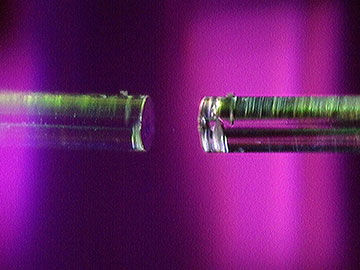
A small concave depression in the surface of an optical fiber. The researchers used a microcavity with two concave mirrors, but this image of a single concave microcavity makes it easier to see the fiber mirror setup. [Image: Photo by Carlos Saavedra / UW–Madison]
The past two decades have witnessed the emergence of several technologies that can measure properties of individual molecules, with applications in biology, immunology, cancer research and other fields. However, nearly all single-molecule approaches use fluorescent labels, which may affect the native functionality of the biomolecules under study.
Now, researchers at the University of Wisconsin–Madison, USA, have developed a label-free single-molecule technique that leverages a fiber-based Fabry–Pérot microcavity (Nature, doi: 10.1038/s41586-024-07370-8). The result is a highly sensitive instrument that can detect individual biomolecules with the highest-reported signal-to-noise ratio (SNR) for label-free single-molecule sensing.
Applying photonics to biomolecules
Recently, researchers demonstrated the successful detection of unlabeled silica nanospheres using a fiber-based, high-finesse Fabry–Pérot cavity system. The microcavity was assembled from two optical fibers with mirror-coated end facets. By probing the cavity with a laser and detecting the transmitted light with a photodetector, the 3D-Brownian motion of the individual nanoparticles in solution could be tracked.
Randall Goldsmith and his colleagues decided to take a similar approach to not only detect but also profile single biomolecules. He noticed the many advances in the photonics community—in particular, those surrounding microphotonic and nanophotonic devices—and sought to apply them to chemistry and biology.
“We live in an amazing time, where there are already multiple ways of detecting single molecules, even in a label-free context,” said study author Goldsmith. “However, being able to detect with such high sensitivity, while also learning something about the conformation of the molecule [and] profiling it, had been an outstanding challenge.”
Going beyond detection
The instrument was able to achieve detection of a ten-amino-acid, 1.2-kDa solution-phase single protein with SNR of up to 123, the highest ever reported for label-free single-molecule sensing by a wide margin.
The single-molecule-sensing instrument couples laser light (660 to 760 nm) into a high-finesse fiber Fabry–Pérot cavity, which is assembled using a fiber splitter from two single-mode optical fibers with end facets coated with high-reflectivity dielectric layers. The transmitted intensity of reflected light is then collected by a photodiode.
Goldsmith and his team also added a novel dynamic thermal priming mechanism for passive mechanical stabilization of the microcavity, as well as active resonance frequency stabilization to amplify the frequency range of Brownian fluctuations above technical and optomechanical noise.
The instrument was able to achieve detection of a ten-amino-acid, 1.2-kDa solution-phase single protein with SNR of up to 123, the highest ever reported for label-free single-molecule sensing by a wide margin. In addition, the platform operates without interaction with surfaces, meaning that crucial information on molecular conformation and binding can be gleaned from measuring diffusion profiles.
“Learning about the conformation of a molecule and how that conformation changes as a function of time, environment, chemical simulation—these are the kinds of questions that get asked by biophysicists and those working in biotechnology every day,” said Goldsmith. “I think this can be a really powerful tool for biotechnology, including drug discovery.”
